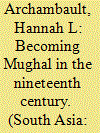| Srl | Item |
| 1 |
ID:
126161


|
|
|
|
|
| Publication |
2013.
|
| Summary/Abstract |
In 1861, Nawab Sikandar Begum, the female ruler of Bhopal, toured Northern India for six months. The journey and its narration in the Taj al-iqbal (1873) were part of a broader project of princely self-fashioning aimed at both indigenous and British audiences. Taking the example of the Begums of Bhopal, this article engages with debates about travel and its relevance to the emergence of a nationalist imaginary, but also of its continuity with alternative visions in the latter half of the nineteenth century. The paper draws upon the insights of revisionist literature on princely states, which stress that princes at the mercy of British power nevertheless remained figures of indigenous authority, retaining a precarious autonomy in their territories. The Begums of Bhopal were able to turn their status as 'loyalists' towards consolidating a 'Mughal' aesthetic by recruiting artists, scholars and poets to underscore the state's autonomy.
|
|
|
|
|
|
|
|
|
|
|
|
|
|
|
|
| 2 |
ID:
052685


|
|
|
|
|
| Publication |
Karachi, Oxford University Press, 2004.
|
| Description |
lv, 315p.Hbk
|
| Standard Number |
0195799585
|
|
|
|
|
|
|
|
|
|
|
|
Copies: C:1/I:0,R:0,Q:0
Circulation
| Accession# | Call# | Current Location | Status | Policy | Location |
| 048273 | 923.1/SUL 048273 | Main | On Shelf | General | |
|
|
|
|
| 3 |
ID:
124955


|
|
|
|
|
| Publication |
2013.
|
| Summary/Abstract |
In 2008, survivors of the 1984 Bhopal Gas Disaster in India undertook a 500-mile march to New Delhi, protesting a long history of governmental neglect of the survivors of the event. This is one episode of a 25-year-old organized international campaign that continues in the present. This article examines the ways in which three bodily substances - blood, hearts and ketones - were produced and circulated through the 2008 protests. Placed within a broader history of substance-politics in the region, this article suggests that these protests produced an imagination of bodily substances that surfaced messy contradictions that became difficult for the Indian State to disregard. This article also shows how these protests distanced themselves from the cynicism attached to similar modes of corporeal activism in the contemporary Indian landscape. In sum, this article traces the production of an activist corporeal counter-discourse that, for at least a time, contaminated the procedures through which the Indian State disregards the health of its marginal citizens.
|
|
|
|
|
|
|
|
|
|
|
|
|
|
|
|